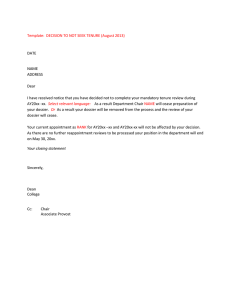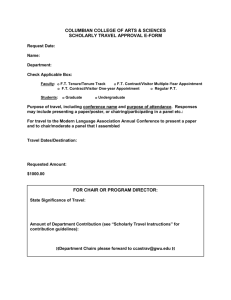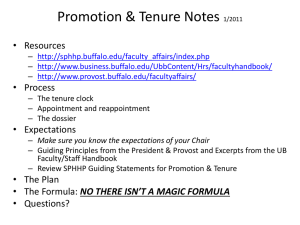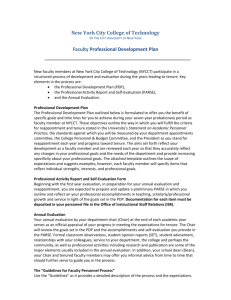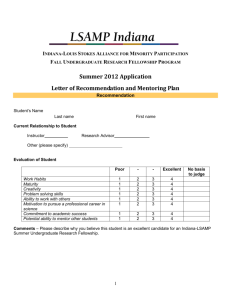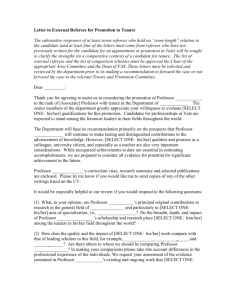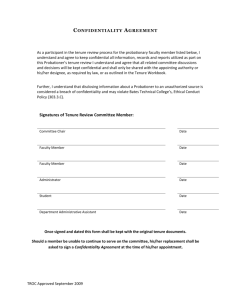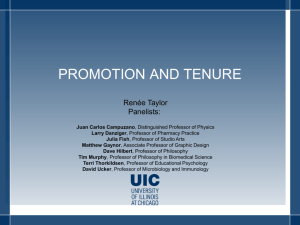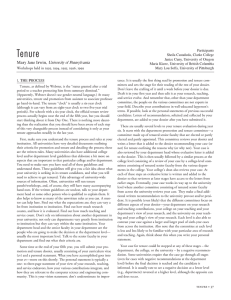Letters of recommendation
advertisement
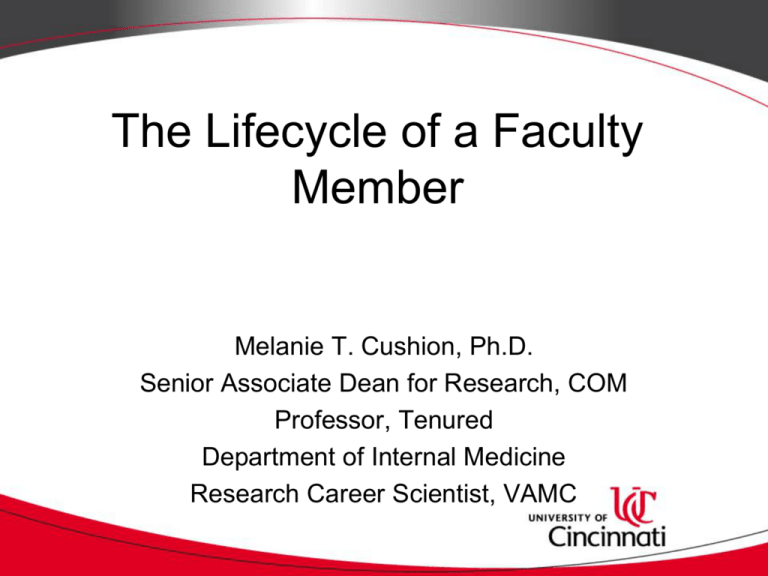
The Lifecycle of a Faculty Member Melanie T. Cushion, Ph.D. Senior Associate Dean for Research, COM Professor, Tenured Department of Internal Medicine Research Career Scientist, VAMC Lifecycle Faculty transition from full-time teaching and research to phased process of professionally rewarding workmentoring, lecturing, philanthropy Emeritus Centers Concept of lifelong learning Need for time and resources to retool skills as knowledge advances in chosen fields Thomas A. Kochan, March/April 2011m MIT Newsletter New and diverse faculty through targeted and strategic recruiting at all levels- University and College efforts Significant losses of young faculty, esp. women due to stressed in this balance UC- LEAF, Provost, AAUP -day care, tenure extensions, time off Unfortunately…. A few things to keep in mind as you begin People you should get to know • Department Chair and division chiefs • Full professors within your department and division • Colleagues with whom a research collaboration is possible • Colleagues who have a good understanding of any health and safety risks associated with your research • Administrators and business administrators – Institutional memory and key contacts • Organizational charts of the College and University Promotion and Tenure Requirements • • • • • • • • • Record of Action form- basic info with position you are seeking Department Director’s recommendation letter and signature on RoA Department APT Committee Chair’s recommendation Curriculum vitae Letters of recommendation – 3 for Instructor to Assistant – 3 external and 3 internal for Asst. to Associate; Associate to Professor and Tenure Review – Clinical, Educator, Field Service, Adjunct, Volunteer and Secondary Tracks- 3 from individuals who can assess activities Letter of appointment Copies of all annual evaluations Personal Statement Documentation of excellence and effectiveness in teaching/and or mentoring Develop a 5 year plan • Sit down and write a 5 year plan • Prepare an experimental schedule for Year 1 • Learn to LOVE Gantt Charts Year 1 • Set up your lab ASAP – Try to remodel, order equipment, hire techs before you arrive • Learn the COM ground rules for tenure • Ask for a faculty mentor if you are not assigned one – Need someone who will help wade through office politics and advise regarding the byzantine academic world – Scientific mentor as well • Get to work – Write up your post doc research if pending – Plan experimental schedule – Apply for small internal and external grants • Accept committee responsibilities, but avoid becoming bogged down – “death by committee” Year 2 • Publish the research you did in your first year • Apply to NIH, DOD etc for small grants (R03, R21, AHA) – HAVE YOUR COLLEAGUES READ YOUR GRANTS • Apply the “Rule of 3” • Consider leadership/management course Year 3- Reappointment time! • Check with mentors that you are on the right course • Get departmental checklist for dossier information • Resubmit R21 etc Submit R01 – Apply for internal funding, small external grants, explore Pharma Years 4, 5 and 6 • • • • • • • • You should begin to be recognized in your field for your research – If not, discuss with mentor, dept. chair for steps towards visibility (e.g. suggestion session on your subspecialty at a national meeting Funding – If you don’t have it, this is a danger – Keep this as your #1 priority Teaching is limited at COM – Participate in ongoing courses as part of a team – Offer to organize a grad school course Review manuscripts Take on departmental and university committee memberships Build your networks within UC and externally Sit on Study sections Write book or reviews To Improve Promotion and Success • MAKE A TIMELINE OF IMPORTANT DATES for the ARPT Process – Provide sufficient prep time (e.g.letters of recommendation turn around) – Be aware of your responsibilities for dossier components To Improve Promotion and Succes DOCUMENTS YOU WILL NEED • Curriculum vitae/ Annual evaluation – Desktop; enter on the fly, both sources – Research Directory; (some Colleges do and some don’t) – THE RULE OF 3 • Activities “count” in 3 different ways, e.g. write a grant, use the Introduction for a review; manuscript, lecture slides (avoid self-plagiarism though) • Join a committee; write a policy (product) that you can claim; identify collaborators or important administrative faculty – STANDARDIZED FORMAT • Reverse chronological order for publications! TIPS • Letters of recommendation – Begin cultivating peers and upper level faculty who are nationally and internationally recognized EARLY (don’t be shy!) • International and national conferences, colloquia, workshops etc • Create a social scientific network to bounce ideas, ask questions, recommend as reviewers – Most will be happy to help as they too have needed such letters and understand the importance of networking – Flattery usually works • Annual evaluations – Update “on the fly” to avoid trying to remember all your accomplishments the day before it is due – Use the time to set realistic goals and assess progress – Update 3-5 year plan based on attainment (or not) of goals – Ask for help – Don’t forget professional development TIPS • Personal Statement – Use to highlight accomplishments, e.g. research grants, awards – Re-iterate how you have “hit” the requirements for promotion/tenure/reappointment – Provide future plans for the upcoming year (s) – Document leadership of other professional training • Documentation of excellence and effectiveness in teaching and/or mentoring – Teaching evaluations standard forms; if not, plan surveys for your students to document teaching effectiveness – Work and subsequent placement of graduate students – Early career faculty should describe their mentoring program – Mid- and senior faculty should list mentees, workshops, seminars devoted to mentoring and successes or learning objectives satisfied of the various programs – Identify leadership in charge of mentoring in your department and volunteer for training and participation The Review Process • Year 2-3 of employment, promotion and tenure dossier is created • Before the end of 3rd year, AAUP-represented faculty committee vote to recommend appointment for another 3 years • After the vote, Dept. Chair meets to discuss any problems that may hinder future progress • The dossier is submitted to the COM ARPT committee then to the Dean- Provost-President- Board of Trustees • Year 5- letters are solicited from internal and external experts in your area • Tenured faculty review dossier and vote on your tenure – Follows same route: Dept. Chair, ARPT committee, Dean, Provost, President, Board of Trustees Right to Appeal • Faculty have the right to write a letter rebutting the Departmental Committee or Department Chair’s recommendation • Entered into the dossier as a formal document
